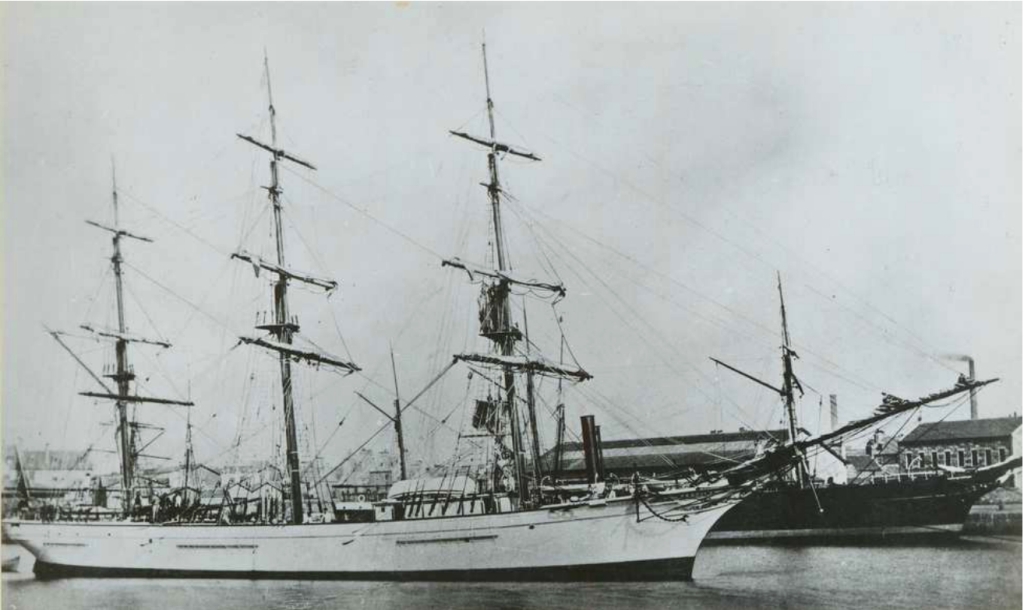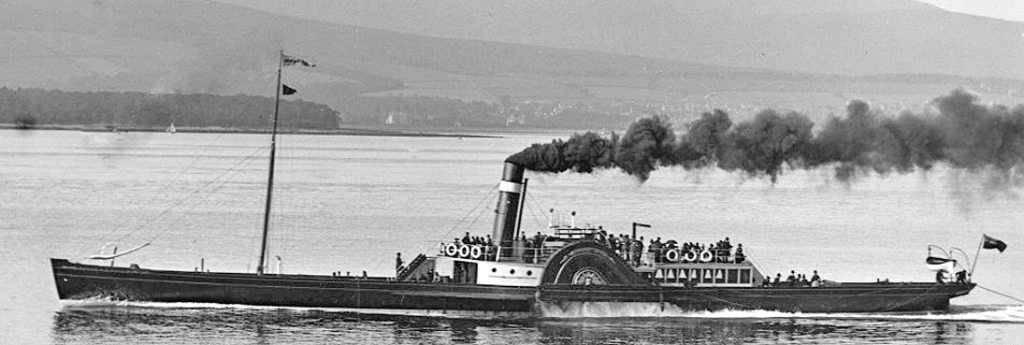John Humphreys Shipyard, Inches 1866-1877

3rd March 1875, The Aberdeen Press & Journal, reported as follows: “Mr John Humphrey applied for a Site for a new Shipbuilding Yard on the Reclaimed Ground to the East of the Wooden Bridge across the Old Channel of the Dee. Mr James Milne said that they had disturbed Mr Humphrey during the Occupancy of his Present Shipyard on the Inches of the Upper Dock, and it would be a very good thing if they could deal leniently with him in taking up a Shipyard on the new Ground. The matter was remitted to the New Works Committee.”
It was after John Smith gave up the Business that John Humphrey & Co commenced on his own, (Humphrey c.1820-84 had been Jack’s Ship’s Draughtsman). The Wreck of the Duke of Sutherland in 1853 was the 1st Job he had in the Salvage line, and it turned out successfully for him; in fact, put him on his feet, and he was ably backed by Messrs John, William, & Alexander Duthie, Sr, who took an interest in him. The Aberdeen Post Office Directory for 1865-66 gives the home address of John Smith as Dee Mouth, South College Street, it also gives the same address for John Humphrey. This House was within easy distance from the Shipyard albeit they had to negotiate the Railway via the old Gas Works in Gas Lane.
Dee Mouth – a large Oblong House at the South end of College Street, (left-hand side with a walled sunken triangular rear Garden) South College Street area Map 1867 (Showing Dee Mouth House)
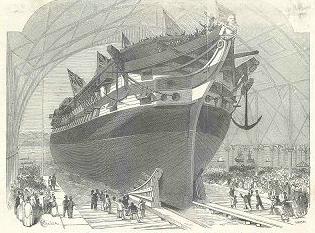
John Humphrey & Co – Shipbuilders 1866–1877
Occupied the Central Yard of the then 3–Inches Shipyards
It is reported that Humphrey’s Yard had a Roofed or Covered Slipway a practice that was at that time common in Aberdeen Shipyards but long-abandoned until Appledore Shipyard re-introduced the practice at their Own Yard in the UK and recommended them in Korean Yards to improve Production. One was later Built in Hall Russell’s Yard but alas too late in life.
1866, 7th December: the Dundee Advertiser reported as follows: “Another Serious Fire at Aberdeen Shipbuilding Premises Destroyed – £4,500 Danmage. 1867 Survey Map of the Inches Area
On Wednesday morning one of the most serious & extensive Fires took place in Aberdeen that has occurred in the City for upwards of 20-yrs. It is rather a remarkable fact that, within the recollections of their oldest Citizens, no large Fire ever took place here without its being followed 1 or 2-others. This Observation has been again verified this week, for on Monday morning an extensive & destructive Fire occurred on the Premises of the Northern Agricultural Company, at Waterloo Quay; and Wednesday morning Fire broke out one of the Shipbuilding Yards at the Inches, whereby Property to the value from £4,500 to £5,000 was totally destroyed. (£540,00 to £600,000 in 2019). About 5-am, Fire was observed issuing from the Roof of the Sawmill & Ship-fitting Shed of John Humphrey, Shipbuilder. The Building contained a quantity of Wood and a Steam Engine & Boiler, from which it supposed the Fire Originated. The Wind at the time the Flames were 1st Observed was blowing pretty Strongly from the South-west, and assisted very materially in spreading the Fire. The Roof of the Building and of those adjoining being all of Wood, and covered with Tar, rendered the material more combustible. The Flames quickly reached the Building occupied by William Duthie Jr, Shipbuilder (to the East of Humphrey’s), for the preparation of Masts, Spars, etc, for Vessels. There was also a large quantity of Cabin Furniture of very considerable value in the place, which was totally destroyed, as was also the whole Building. The Fire next took hold of David Burn’s Shed, which contained a large quantity of Timber, and which was also burned to the Ground. The Stabling of Mr Smart, Railway Carrier, in which there were number of Horses, was also Destroyed by the Fire. The Horses however, got out without being at all injured. Mr Paterson’s Woodyard, to the East of Duthie’s Premises, was also overtaken by the Flames, and the whole of the Wood almost entirely destroyed. The Old Oak Tree, which has stood on the opening to the River Dee directly in Regent Road opposite Marischal Street for a great number of years, has also been damaged very considerably. The Fire entered its core, and the Paling by which was protected was completely burnt, but after great exertion the Tree was partially saved and still standing. As soon as the Fire was observed in the Sheds, information was sent to the Police and the whole of the Fire-engines & Brigade – under the direction of Mr Duthie Superintendent of the Police, and Mr Cruickshank, the Inspector were speedily on the spot. The Engines were promptly set to work – water being obtained in abundance from the Dee and from the Harbour. Besides the Engines, a Hose from one the Building Yards was also put in active Pperation. Notwithstanding the strenuous endeavours of the Firemen to extinguish the Fire, the Flames were carried to the other side of the Street to the Building Yard of Wm Duthie Jr. It started in the Gable of one of the Sheds in which the Building of a new Ship was being proceeded with. Luckily at this time the Wind veered a little further to the West, and with 3-Engines playing upon the Shed, the Flames were there Extinguished before any damage had been done to the Ship or any other part of the Building except40-Barrels of Tar were Deposited, and were in great danger. Had the Flames reached them it would have accelerated the extension of the Fire very considerably. About 6-am, the Fre had reached its height, and the blaze attracted much attention over the whole City; so much so, in fact, that we are told a person could have seen the hours upon any of the Public Clocks through the Town. In A & G Paterson’s Woodyard, as we have said, the Property consisted almost exclusively of Timber, while in the others there were Engines, which were partially Destroyed, and a large quantity of Workmen’s Tools, mostly all which were lost. The Damage, on the whole, is estimated at about £4,500 to £5,000. A & G Paterson’s Property is, we learn, uninsured; and that of the others only partially. About 7.30-am the Flames were almost entirely subdued, and the scene was one of Demolition & Destruction. The whole of the Buildings we have mentioned were burned to the Ground, and in the Forenoon large piles of half burnt Wood, and the Brickwork protecting the Engines, were only to seen. The Ashes continued to smoulder till the afternoon, up to which time several of the Fire Engines continued working. Great credit is due to Mr Duthie, the Superintendent of Police, for the efficient manner in which he conducted the arrangements at much personal risk, and also to his Assistants, who certainly did everything in their power to extinguish the Flames and also to prevent their extension. Captain Balfour, of the RNR Training Ship Winchester, and his men, also deserve the greatest praise for the able Assistance rendered by them. About 50 of the Soldiers in the Castlehill Depot Battalion were also turned out, and were of great Service in the Operations. Although the Fire was of great magnitude, it is very fortunate that it did not get a proper Hold on the Shipbuilding Yards the opposite side of the Street, otherwise the consequences would have been far more serious than what they were, in all probability the Ships in the Upper Dock would not have escaped untouched. A great number of Spectators were present, but we are glad to state that no Personal accidents have taken place.”
Smart, J. C, Deeside Railway Carrier, h. 48-Dee Street. A & G Paterson, Wood Merchants, c.1853
“The Old Oak Tree”
Much Excavation had to be made in the inner part of the Upper Harbour alongside the Quay, and in 1832 a large Oak tree was found within 150 yards of the Incorporated Trades Hospital, which was near the bottom of Exchange Street. It was within a few inches of the surface and some people remembered seeing part of a Branch of it projecting above the ground in the edge of the Trinity Inche. When taken out it was found to be 20ft 2in. in Circumference, and the Trunk was 6ft 6in. in length from the Root to the 1st Branch, which was 23ft-6in. long & 13ft-10ins in Circumference. Part of another Limb was 6ft 7in. in Circumference & 3ft long. The Tree was lying horizontally from South-east to North-west. It was not much decayed and did not seem to have lain very long where it was found. There were many Ancient Oak Trees in the Forest of Birse, and as that Parish is liable to heavy rains, causing Floods in the Feugh when the wind is in the South-east in Autumn, the Tree may have come from Birse. A South-east wind would have prevented it from going out to Sea and would have blown it into the North-west corner of the Estuary of the Dee. There were Ancient Oaks in some parts of Aberdeenshire, but the Oak rarely produces ripe acorns in the North of Scotland, and most likely they had been grown from Acorns imported from England. The introduction of the Oak into Scotland may be ascribed either to Margaret, wife of Malcolm Canmore, an English Lady, or to David I, her youngest son, who had been much in England before he became King. The Oak Tree was set up near the Main Inches (now Commercial Road) at the far end of Regents Road in 1836, where it stood till it was found to be somewhat in the way. It had also suffered badly from a Fire in adjoining Timber Yards (See report above) then lining the River Dee and was therefore removed to the Duthie Park. The Oak seems scarce to thrive now in this part of the Country, although in executing the improvements which have lately been carried on in the Harbour of Aberdeen, the Trunks of a good many Oaks of large size have been dug up, in such situations as to lead to the conclusion that they had not been brought down by the River, but had grown where they were found. One of these, which, when entire and covered with its bark, must have exceeded 15ft in circumference, was set upon the Inch or flat ground between the Basin of the Harbour and the Original Bed of the River Dee.
Kagoshima – Built 1866 Humphrey’s Shipyard for Glover Brothers
Original Owner: James Lindley Glover, Shipowner (Aberdeen)
18th February 1867: James Lindley Glover 28/64 to Charles Thomas Glover, Shipowner, 2-Albert Street, Aberdeen.
15th October 1868: Thomas Blake Glover, Merchant, Nagasaki, Japan, empowered to Sell the Ship for a sum not less than £500 Sterling at any Port in China or Japan within 12-months.
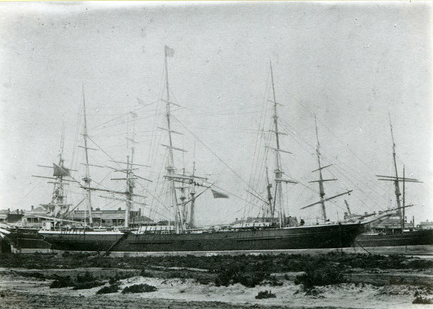
1867 – Carnaqueen
Ship Registered at Aberdeen 23rd April 1867.
Length 187′ x Breadth 33′ x Depth 19′
Gross Tonnage 825-Ton
Registered Tonnage: 950-Ton
Description: 1-Deck with a Poop Deck, 3 Masts, Ship-rigged, eliptical Stern, Carvel built, no Galleries, Demi Male Figurehead.
Shipmaster, Aberdeen (8 shares); James Wood, merchant, Banff (8 shares).
Daily News, 22nd May 1867:
Aberdeen Clipper Ship Carnaquheen, A1, 825-Tons Register, R Phillips Commander, lying in the London Docks. Devitt & Moore’s Australian Line of Packet Ships – for Adelaide direct (last Shipping Day 5th June), This new beautiful Ship, fitted expressly for the Adelaide Trade, has a full Poop, with every comfort for the Accommodation of Chief Cabin & Intermediate Passengers.
South Australian Register (Adelaide), 19th September 1872:
[From Wallaroo Times] Considerable excitement in Wallaroo when it was known elder Liner Carnaqueen was hard and fast on Tipara Reef (Spencer Gulf). Captain Colville was on the Gulf for 1st time. He was aware of the Reef, set what he thought a correct Course and went to his Cabin to rest. When he came on Deck he considered Land too near and ordered Course to be altered, but soon after she Struck the Reef at 6-Knots. Water was pumped out of her and also over 100-tons of Coal unloaded. At High-water she began to move on the Reef, but could not be kedged off. A Steamer, sent from Adelaide, arrived just in time to pull her clear. Carnaqueen is an Aberdeen Clipper Ship. The Captain has a share in her and probably will be the greatest sufferer from the misfortune.
South Australian Advertiser, 24th September 1880:
News reached London 22nd September that Ship Carnaqueen, A1, Captain J Simpson, belonging to Messrs Jacobs Bros & Co of London, bound from Antwerp to Sydney, has Foundered at Sea. It is feared that a large number of those Aboard have perished.
1869 – Bundaleer – Date of Build/Launch: March 1869 at Humphrey’s Shipyard (Inches). Richard Connon & Co, Shipowner d. c.1869 (Connon & Co) Port belonging to: Aberdeen. Registered 22nd April 1869; 1-Deck, Poop Deck & Forecastle; 3-Masts; ¾-Male Figurehead.
1872 – Wooden Screw Steamer ‘Volant’ Registered Aberdeen 7th February 1873. 1-Deck, 2-Masts, Schooner Rig, Wood framework.
Engines: 2-40HP diagonal surface condensing by Pressly & Leys, Engineers, Blacksmiths & Machine Makers, Inches Aberdeen. James Pressly (of Pressly & Leys), 17-Jasmine Terrace, Aberdeen.
Original Owners: Richard Connon, Shipowner (20-Shares); Alexander Rhind Dyer, Shipowner (20); John Humphrey, Shipbuilder (24) – All of Aberdeen.
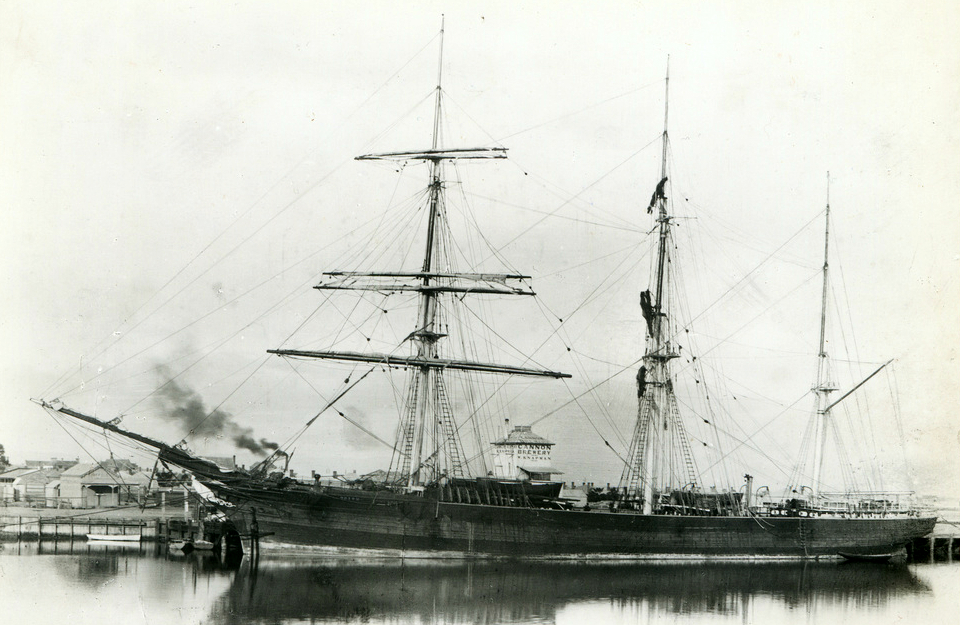
1874- Invercauld: Launched 18th September 1874
Rig: Ship, Port: Aberdeen 1320-Gross Tonnage
Description: 2-Decks, 3-Masts, Ship-rig, elliptical Stern, Carvel built, no Galleries, ¾-male Highlander Figurehead, Wood Frame.
Subscribing Owners: Richard Connon & Alexander Rhind Dyer, Shipowners (40-Shares), George Milne, Banker (8-Shares), Robert Phillips, Master Mariner (8-Shares), all Aberdeen. James Wood, Merchant, Banff (8-Shares).
Brisbane Courier, 23rd December 1874:
A splendid specimen of an Aberdeen Clipper Ship, the Invercauld, has been successfully Launched from the Yard of Messrs John Humphrey & Co, into the Upper Dock, largest ever Built at the West End Inches Yards – therefore some anxiety was felt by the Bystanders for the safety of the Colossal Vessel as she Glided down the Ways which was safely reached without a single hitch. When fairly clear of the ‘Building Shed‘ (Covered Slipway) & Afloat, her fine symmetrical form was fully exposed to view and much admired by all Observers. She has a finely-modelled Figurehead, representing a stalwart Highlander Clad in Farquharson Tartan. Built under Lloyd’s Special Survey to Class 12-yrs, has Iron Masts, Keelson & Hold Beams and 2-Decks which, with a great height between them, makes her very eligible Ship for Emigrants. Has been Built to Order of Richard Connon & Co and is intended for the Adelaide Trade. Will be under Command of Captain Robert Philips, long connected with that Trade and will take her place in the Elder Line of Aberdeen Clippers as Sister Ship to Monaltrie (June 1872), Craigendarroch (1870) & Bundaleer (1869).
Liverpool Mercury, 31st March 1885:
For Sale 23rd April by Kellock & Co, Brokers, Liverpool, the very superior A1 Clipper Ship Invercauld, 1247-Tonnes Register. Built by John Humphrey & Co under special Survey at Aberdeen under a ‘Roofed‘ Slipway 1874. Is Salted & Copper Fastened, was Sheathed with Yellow Metal (Brass) July 1883. Carries over 1700-Tons deadweight – is absolutely found in Stores and ready for immediate Employment. Has just discharged a Cargo of Java Sugar in excellent order. Lying in East Float, Birkenhead.
Particulars from Messrs James Aiken Jr & Co, Aberdeen. Shipowner (57-Marischal Street).
Invercauld – Reported missing October 1901. The Ship left Flinders Bay in Western Australia loaded with Timber en route for Newcastle, England, 2nd October 1901 and vanished without a Trace. The Crew consisted of 15-men. The Ship apparently Sank in a Hurricane in the Indian Ocean.
1877 – Cleopatra – Rig: Barque. Length 139′ x Breadth 28′ x depth 18′-6′
Gross tonnage: 408-Ton
Owner: Richard Connon & Co Aberdeen
Aberdeen Weekly Journal 26th December 1877
Barque Cleopatra, which was the Last Vessel Built by Messers Humphrey & Co, Aberdeen, left this Port for London in charge of Captain F G Milne. She belongs to Messrs Richard Connon & Co, Aberdeen.
Aberdeen Weekly Journal, 30th March 1878:
According to a Telegram from Lloyd’s agent in Pernambuco, the new Barque Cleopatra, which left London towards the middle of February with General Cargo for Port Philip, has gone ashore at Ponta Pedras, the Eastermost point of Brazil and has become a Wreck. It is expected that part of her Cargo will be recovered. Later Telegram states Crew were saved and recovering Cargo.
Daily News, 27th April 1878:
12 of Crew of Barque Cleopatra Landed in Liverpool. Barque went Ashore near Pernambuco, she afterwards capsized and the crew narrowly escaped. About 60-Natives armed with knives boarded the stranded Vessel, plundered Cargo & robbed Crew, whom they threatened.
Aberdeen Weekly Journal 25th August 1878:
Papers from Naval Courts held at Pernambuco re loss of Cleopatra have been issued. On 6th April Mr Walker, British Consul, reported the Wreck to Board of Trade – after Wrecked, Natives began to plunder the Vessel. Captain Prothero appeared 2-days after, saying he had been detained by the Natives. Twice he refused to attend a Naval Court Martial. When Officers were sent to apprehend him he barricaded his door and evaded capture for several days. When finally brought to Trial the Captain behaved in a very eccentric manner, snapping his fingers at President of the Court Martial. Finally Court found him Guilty of neglecting to attend to his work, of delaying to pay off & discharge Crew and of Contempt of Court. Charge of Drunkenness was found not proven. Assessor remarked that during Trial he behaved ”as only a man suffering from great mental excitement or monomania would do”. Court suspended his Master’s Certificate for 12-months and Imprisoned him until the Mail Steamer sailed. Board of Trade subsequently returned Master’s Certificate because of doubts about Jurisdiction of Court Martial.
c.1875 John Humphrey lived in Ruthven House, Ruthrieston, this was a Grand Building which showed his Status in the Community, William Hall (1806-1887), of Hall, Russell & Co., Shipbuilders, Footdee, lived a little further West at No.74 Riverside Drive, in a similar sized Mansion. However, by 1876 John Humphrey was living in a Flat at No.2 Trinity Quay. Sometime later he moved to Dundee & in 1884 he is thought to have committed Suicide by jumping off the Paddle Steamer the ‘Marquis of Bute’ whilst it sailed along the River Clyde.
The Last Vessel Launched at the Inches (Upper Dock) was the Screw Steamer ‘Nancy Lee’ (97-Tons) built by John Humphrey & Co, she was Launched in 1879.
1884, 21st April: John Humphrey a Resident of Dundee, died at Greenock, after either falling or jumping off the Ship ‘Marquis of Bute’ into the River Clyde between Dunoon & Innellan, he was 54-yrs old according to the Glasgow Evening Post.


